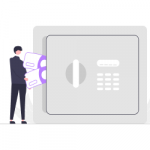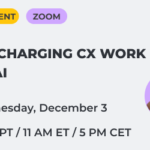Our new guest in the Journey Mapping Interview Series is Paul Lopushinsky, the Founder of Playficient. After years of working on the user experience, Paul found that most companies he worked at spent little to no time investing in their employee experience (EX). So, eventually, he decided to take these ideas and concepts from his work and apply them to the world of EX.
To start off on the right foot with EX mapping, let’s find out we even need to to focus on personnel in our increasingly customer-centric world.
The value of EX journey mapping
Companies that make use of customer journey mapping enjoy lower customer service costs, greater return on marketing investments, and more. But there is a direct connection between both employee and customer experience. Investing in EX results in higher engagement and lesser turnover, as a result.
“Take care of your employees, and they will take care of your customers, ”
Richard Branson
Case in point. One of the essential EX components is onboarding. Improving the onboarding experience for new team members would bring better long-term results like higher retention rates and better staff satisfaction. And if, hypothetically speaking, the turnover rate reduces from 50 to 20 specialists per year, that would make a huge difference for a business.
How do you measure EX?
The current situation with the pandemic has pushed forward the need to keep a pulse on workers. In the short term, you can do that with the help of the Net Promoter Score (NPS) and polls. And if we are talking about long-term perspectives, the turnover rate is a great indicator if you are doing things right.
Employee journey stages
Depending on the organization, there can be up to ten steps in an EX journey map:
- Sourcing/recruiting
- Pre-boarding
- Onboarding
- Compensation and benefits
- Ongoing learning development
- Ongoing engagement
- Rewards and recognition
- Performance planning
- Feedback and review advancement
- Retire/Resign
Onboarding is perhaps the most important stage that organizations can work on to improve the overall EX. Many companies, particularly tech ones, put a lot of effort into recruiting and getting people in the door, but they have nothing to follow up. Especially now that many companies have switched to remote work, new workers don’t have an office to go to; they just log into Slack. And since they are not given any indication of what to expect, they feel lost.
But ideally, joining an organization needs to feel like joining a party where people have known each other for years. We need to bring people up to speed and get them going on.
Building an EX journey map: research methods and personas
To start things off, it’s good to have conversations with staff members and pick up details, key phrases, and other relevant information. Our recommendation is not to take their answers at face value because there is a difference between what we say vs what we mean vs what we do vs what we feel.
There is the “Five Whys” technique that can help you dive deeper. After you get an answer to your initial question, you go ahead and ask a why question to that answer. And around the fifth “Why?”, you can get to the bottom of things and figure out what works and what does not.
But what if an organization has hundreds or thousands of workers? How do you scale your conversations? There is another great rule that also makes use of five. Get feedback from five people and look for patterns and similarities. These details could indicate what works and what needs improvement.
Personas can also be very instrumental in EX mapping. A good thing to remember is to make your personas as visual as possible. You can go from seniority levels and departments — you can have someone starting at a junior position (whether a developer, a marketer, an accountant, etc.) or even a college grad, or you can have a person coming into middle management or a person hired into the VP level. Some values, practices, and expectations, may also vary based on culture for companies with diverse teams and that are managing global payrolls. As opposed to customer personas, you may have a better intuition for your employee personas as those are people you are working with every day.
Mapping an entire journey vs. mapping a stage
Depending on your focus, maps can be different, too. You can try to build a map encompassing an entire journey from recruiting to retirement. But overhauling everything at once is a monumental task. Another — more efficient — approach would be to focus on one or two stages that need improvement and then go from there.
It’s also important to show where your company is currently at in terms of EX and where you want it to be.
Emotional experience of employees
Emotions and feelings are a crucial component of the overall journey, as we are all emotional creatures.
To better understand your staff members, try asking these three questions at every stage:
- What is the worker trying to do?
- What was the person thinking or feeling (the emotional aspect)?
- What barriers are getting in the way?

Tips for beginners
Every journey starts with the first step. And this step doesn’t have to be big. Start small by thinking what’s one small thing you can do to move forward — is it doing more research, finding weaknesses in touchpoints, and more.
Three how-to’s to get you started
- How to get stakeholders’ buy-in for EX mapping
The key thing is to know your audience and tell a good story. Are your stakeholders driven by emotions or are they more numbers-based? Knowing what guides their decisions, you can tweak your story accordingly.
Also remember that an EX project is never an isolated initiative. While you have a core, HR-based team that spearheads the efforts, anyone with relevant input can participate in it.
- How to run a remote mapping session
Whether you are using Zoom or other conferencing systems, you can use digital whiteboards, like Stormboard, and other annotation tools for digital post-it notes. Another tip is to organize participants into several rooms and give them prompt questions for discussion, and then bring them back together to share insights.
- How to capture personnel’s changing needs over time
When doing a journey map, it’s not a “one and done” approach. A journey map is not set in stone. It will incrementally change. To account for these changes, you can include contingencies and things you can predict like the emergence of a hybrid model of working from home and from the office.
Wrapping up
EX journey mapping is a powerful tool that helps companies reveal how the staff is actually feeling about an organization, discover any weaknesses, and optimize the overall EX strategy. And building a positive experience can go a long way towards keeping your workers more engaged, motivated, and productive. This, in turn, leads to lower absenteeism rate, higher quality of work, and ultimately impacts the company’s bottom line.
Bonus: a recording
This blog article is based on Paul's talk about EX journey mapping at our recent event. You can watch the recording here:








Thanks for having me on! Was a really great interview. Great questions!
Thank you, Paul, for agreeing to speak at our event. It was a real pleasure to work with you.
Thank YOU! The hour flew by too fast Would love to see you back with even more insights!